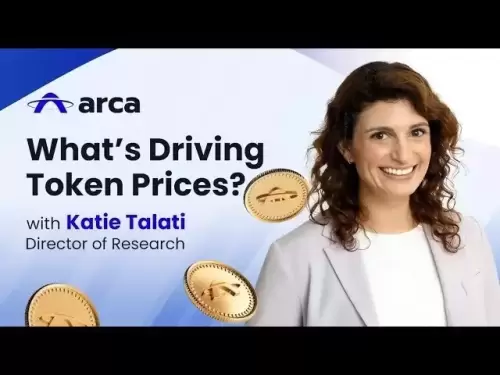-
 Bitcoin
Bitcoin $107,275.1551
-0.32% -
 Ethereum
Ethereum $2,485.3056
1.77% -
 Tether USDt
Tether USDt $1.0005
0.03% -
 XRP
XRP $2.2223
1.31% -
 BNB
BNB $657.7608
1.39% -
 Solana
Solana $156.3566
3.02% -
 USDC
USDC $0.9999
0.01% -
 TRON
TRON $0.2791
1.09% -
 Dogecoin
Dogecoin $0.1651
0.45% -
 Cardano
Cardano $0.5738
2.78% -
 Hyperliquid
Hyperliquid $40.2672
5.82% -
 Bitcoin Cash
Bitcoin Cash $517.5487
5.30% -
 Sui
Sui $2.7981
-0.40% -
 Chainlink
Chainlink $13.3500
-0.36% -
 UNUS SED LEO
UNUS SED LEO $9.1220
1.12% -
 Avalanche
Avalanche $17.9515
-0.32% -
 Stellar
Stellar $0.2361
-0.44% -
 Toncoin
Toncoin $2.9423
2.33% -
 Shiba Inu
Shiba Inu $0.0...01145
-0.68% -
 Litecoin
Litecoin $86.1693
-0.63% -
 Hedera
Hedera $0.1493
0.64% -
 Monero
Monero $315.1374
1.81% -
 Polkadot
Polkadot $3.4002
-0.73% -
 Dai
Dai $1.0001
0.03% -
 Bitget Token
Bitget Token $4.5413
-1.35% -
 Ethena USDe
Ethena USDe $1.0002
-0.01% -
 Uniswap
Uniswap $7.1733
-0.57% -
 Aave
Aave $274.0465
-0.23% -
 Pepe
Pepe $0.0...09810
2.24% -
 Pi
Pi $0.5101
-3.10%
How to avoid slippage when buying and selling Forta (FORT) coins?
To minimize slippage when buying FORT coins, it's advisable to use limit orders during periods of low market volatility, breaking up larger orders into smaller ones to reduce their impact on market price.
Jan 09, 2025 at 12:39 am

Key Points to Avoid Slippage When Buying and Selling Forta (FORT) Coins
- Understanding slippage and its causes
- Comparing centralized exchanges vs. decentralized exchanges
- Using limit orders instead of market orders
- Trading during periods of low market volatility
- Breaking up large orders into smaller ones
Comprehensive Guide to Avoiding Slippage in FORT Transactions
1. Grasping Slippage and Its Origins
Slippage is a common phenomenon in cryptocurrency trading that refers to the difference between the expected execution price and the actual price at which a trade is executed. This discrepancy can arise due to various factors, including:
- Market Volatility: Rapid price fluctuations can lead to significant slippage, particularly for large orders.
- Order Execution Time: Delays in order execution can cause the market price to change, resulting in slippage.
- Order Placement: Ill-timed or poorly placed orders increase the likelihood of slippage.
- Order Type: Market orders, which are executed immediately at the current market price, are more susceptible to slippage. Conversely, limit orders offer greater control over execution price.
2. Centralized vs. Decentralized Exchanges
Centralized exchanges (CEXs) offer a centralized trading platform, often with high liquidity and user-friendly interfaces. However, they may charge trading fees and have withdrawal limits.
Decentralized exchanges (DEXs) provide a peer-to-peer trading environment, eliminating intermediaries and offering anonymity. However, they may have lower liquidity and can be more challenging to use.
When choosing an exchange to trade FORT, consider the following factors:
- Trading Fees: CEXs typically charge lower fees than DEXs.
- Liquidity: CEXs offer higher liquidity, reducing slippage risks.
- Security: Both CEXs and DEXs employ robust security measures.
- User Experience: CEXs generally offer more user-friendly interfaces.
3. Utilizing Limit Orders to Mitigate Slippage
Limit orders allow traders to specify the desired execution price for their trades. By placing a limit order to buy or sell FORT at a specific price, slippage risks are greatly reduced.
- For Buying FORT: Set a limit order slightly above the current market price to ensure execution at or below that price.
- For Selling FORT: Set a limit order slightly below the current market price to guarantee execution at or above that price.
While limit orders provide more control, they may take longer to execute, especially in volatile markets.
4. Trading During Low-Volatility Periods
Market volatility can exacerbate slippage. By trading during periods of low market volatility, the likelihood of significant slippage is diminished.
- Monitor Market Trends: Utilize technical analysis or market sentiment indicators to identify periods of low volatility.
- Execute Trades During Off-Peak Hours: Market activity and volatility tend to be lower during off-peak hours, reducing slippage risks.
- Avoid News-Driven Events: Major news announcements or market events can trigger high volatility, increasing the potential for slippage.
5. Dividing Large Orders into Smaller Ones
Breaking large FORT orders into smaller ones can help minimize slippage. By executing multiple smaller orders over a period of time, the impact of each individual order on the market price is reduced.
- Calculate Optimal Order Size: Determine the maximum order size that can be executed without causing excessive slippage based on market liquidity.
- Stagger Order Execution: Execute the smaller orders gradually, allowing the market to absorb each one before placing the next.
- Monitor Market Response: Continuously monitor the market response and adjust the order size or execution strategy as needed.
Frequently Asked Questions (FAQs)
What is slippage in cryptocurrency trading?
Slippage is the difference between the expected execution price and the actual price at which a trade is executed.
What causes slippage when trading FORT coins?
Slippage can be caused by market volatility, order execution time, order placement, and order type.
How can I avoid slippage when buying FORT coins?
Use limit orders to specify the desired execution price, trade during periods of low market volatility, break up large orders into smaller ones, and consider using a centralized exchange with high liquidity.
How can I avoid slippage when selling FORT coins?
Place a limit order slightly below the current market price to guarantee execution at or above that price, trade during periods of low market volatility, break up large orders into smaller ones, and consider using a centralized exchange with high liquidity.
What is the difference between a limit order and a market order?
A limit order specifies the desired execution price, while a market order is executed immediately at the current market price. Limit orders provide greater control over execution price but may take longer to execute.
Disclaimer:info@kdj.com
The information provided is not trading advice. kdj.com does not assume any responsibility for any investments made based on the information provided in this article. Cryptocurrencies are highly volatile and it is highly recommended that you invest with caution after thorough research!
If you believe that the content used on this website infringes your copyright, please contact us immediately (info@kdj.com) and we will delete it promptly.
- OKX and Binance Delist Trading Pairs: What's Going On?
- 2025-07-01 02:30:12
- Pepeto vs. Shiba Inu: Can the New Meme Coin Dethrone the King?
- 2025-07-01 02:50:11
- Saylor, Bitcoin, Holdings: Strategy's Crypto Empire Grows
- 2025-07-01 02:30:12
- Coinbase, Altcoins, and Listings: What's the Buzz?
- 2025-07-01 00:30:11
- Chainlink's Bullish Signals: Investors Bet on Long-Term Value
- 2025-07-01 00:50:12
- CICADA Finance Soars on BNB Chain: A TGE Deep Dive
- 2025-07-01 01:30:11
Related knowledge

How to customize USDT TRC20 mining fees? Flexible adjustment tutorial
Jun 13,2025 at 01:42am
Understanding USDT TRC20 Mining FeesMining fees on the TRON (TRC20) network are essential for processing transactions. Unlike Bitcoin or Ethereum, where miners directly validate transactions, TRON uses a delegated proof-of-stake (DPoS) mechanism. However, users still need to pay bandwidth and energy fees, which are collectively referred to as 'mining fe...

USDT TRC20 transaction is stuck? Solution summary
Jun 14,2025 at 11:15pm
Understanding USDT TRC20 TransactionsWhen users mention that a USDT TRC20 transaction is stuck, they typically refer to a situation where the transfer of Tether (USDT) on the TRON blockchain has not been confirmed for an extended period. This issue may arise due to various reasons such as network congestion, insufficient transaction fees, or wallet-rela...

How to cancel USDT TRC20 unconfirmed transactions? Operation guide
Jun 13,2025 at 11:01pm
Understanding USDT TRC20 Unconfirmed TransactionsWhen dealing with USDT TRC20 transactions, it’s crucial to understand what an unconfirmed transaction means. An unconfirmed transaction is one that has been broadcasted to the blockchain network but hasn’t yet been included in a block. This typically occurs due to low transaction fees or network congestio...

How to check USDT TRC20 balance? Introduction to multiple query methods
Jun 21,2025 at 02:42am
Understanding USDT TRC20 and Its ImportanceUSDT (Tether) is one of the most widely used stablecoins in the cryptocurrency market. It exists on multiple blockchain networks, including TRC20, which operates on the Tron (TRX) network. Checking your USDT TRC20 balance accurately is crucial for users who hold or transact with this asset. Whether you're sendi...

What to do if USDT TRC20 transfers are congested? Speed up trading skills
Jun 13,2025 at 09:56am
Understanding USDT TRC20 Transfer CongestionWhen transferring USDT TRC20, users may occasionally experience delays or congestion. This typically occurs due to network overload on the TRON blockchain, which hosts the TRC20 version of Tether. Unlike the ERC20 variant (which runs on Ethereum), TRC20 transactions are generally faster and cheaper, but during...

The relationship between USDT TRC20 and TRON chain: technical background analysis
Jun 12,2025 at 01:28pm
What is USDT TRC20?USDT TRC20 refers to the Tether (USDT) token issued on the TRON blockchain using the TRC-20 standard. Unlike the more commonly known ERC-20 version of USDT (which runs on Ethereum), the TRC-20 variant leverages the TRON network's infrastructure for faster and cheaper transactions. The emergence of this version came as part of Tether’s...

How to customize USDT TRC20 mining fees? Flexible adjustment tutorial
Jun 13,2025 at 01:42am
Understanding USDT TRC20 Mining FeesMining fees on the TRON (TRC20) network are essential for processing transactions. Unlike Bitcoin or Ethereum, where miners directly validate transactions, TRON uses a delegated proof-of-stake (DPoS) mechanism. However, users still need to pay bandwidth and energy fees, which are collectively referred to as 'mining fe...

USDT TRC20 transaction is stuck? Solution summary
Jun 14,2025 at 11:15pm
Understanding USDT TRC20 TransactionsWhen users mention that a USDT TRC20 transaction is stuck, they typically refer to a situation where the transfer of Tether (USDT) on the TRON blockchain has not been confirmed for an extended period. This issue may arise due to various reasons such as network congestion, insufficient transaction fees, or wallet-rela...

How to cancel USDT TRC20 unconfirmed transactions? Operation guide
Jun 13,2025 at 11:01pm
Understanding USDT TRC20 Unconfirmed TransactionsWhen dealing with USDT TRC20 transactions, it’s crucial to understand what an unconfirmed transaction means. An unconfirmed transaction is one that has been broadcasted to the blockchain network but hasn’t yet been included in a block. This typically occurs due to low transaction fees or network congestio...

How to check USDT TRC20 balance? Introduction to multiple query methods
Jun 21,2025 at 02:42am
Understanding USDT TRC20 and Its ImportanceUSDT (Tether) is one of the most widely used stablecoins in the cryptocurrency market. It exists on multiple blockchain networks, including TRC20, which operates on the Tron (TRX) network. Checking your USDT TRC20 balance accurately is crucial for users who hold or transact with this asset. Whether you're sendi...

What to do if USDT TRC20 transfers are congested? Speed up trading skills
Jun 13,2025 at 09:56am
Understanding USDT TRC20 Transfer CongestionWhen transferring USDT TRC20, users may occasionally experience delays or congestion. This typically occurs due to network overload on the TRON blockchain, which hosts the TRC20 version of Tether. Unlike the ERC20 variant (which runs on Ethereum), TRC20 transactions are generally faster and cheaper, but during...

The relationship between USDT TRC20 and TRON chain: technical background analysis
Jun 12,2025 at 01:28pm
What is USDT TRC20?USDT TRC20 refers to the Tether (USDT) token issued on the TRON blockchain using the TRC-20 standard. Unlike the more commonly known ERC-20 version of USDT (which runs on Ethereum), the TRC-20 variant leverages the TRON network's infrastructure for faster and cheaper transactions. The emergence of this version came as part of Tether’s...
See all articles

























































































